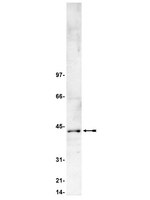Calcium dependence of polycystin-2 channel activity is modulated by phosphorylation at Ser812.
Cai, Y; Anyatonwu, G; Okuhara, D; Lee, KB; Yu, Z; Onoe, T; Mei, CL; Qian, Q; Geng, L; Wiztgall, R; Ehrlich, BE; Somlo, S
J Biol Chem
279
19987-95
2004
Mostrar resumen
Polycystin-2 (PC-2) is a non-selective cation channel that, when mutated, results in autosomal dominant polycystic kidney disease. In an effort to understand the regulation of this channel, we investigated the role of protein phosphorylation in PC-2 function. We demonstrated the direct incorporation of phosphate into PC-2 in cells and tissues and found that this constitutive phosphorylation occurs at Ser(812), a putative casein kinase II (CK2) substrate domain. Ser(812) can be phosphorylated by CK2 in vitro and substitution S812A results in failure to incorporate phosphate in cultured epithelial cells. Non-phosphorylated forms of PC-2 traffic normally in the endoplasmic reticulum and cilial compartments and retain homo- and hetero-multimerization interactions with PC-2 and polycystin-1, respectively. Single-channel studies of PC-2, S812A, and a substitution mutant, T721A, not related to phosphorylation show that PC-2 and S812A function as divalent cation channels with similar current amplitudes across a range of holding potentials; the T721A channel is not functional. Channel open probabilities for PC-2 and S812A show a bell-shaped dependence on cytoplasmic Ca(2+) but there is a shift in this Ca(2+) dependence such that S812A is 10-fold less sensitive to Ca(2+) activation/inactivation than the wild type PC-2 channel. In vivo analysis of PC-2-dependent enhanced intracellular Ca(2+) transients found that S812A resulted in enhanced transient duration and relative amplitude intermediate between control cells and those overexpressing wild type PC-2. Phosphorylation at Ser(812) modulates PC-2 channel activity and factors regulating this phosphorylation are likely to play a role in the pathogenesis of polycystic kidney disease. | 14742446
 |
Proteomic analysis of proteins in PC12 cells before and after treatment with nerve growth factor: increased levels of a 43-kDa chromogranin B-derived fragment during neuronal differentiation.
C M Huang,H A Shui,Y T Wu,P W Chu,K G Lin,L S Kao,S T Chen
Brain research. Molecular brain research
92
2001
Mostrar resumen
Proteomic analysis is an important approach to characterizing the proteome and studying protein function in the post-genomic era. It is also a powerful screening method for detecting unexpected alterations in protein expression that may be missed by conventional biochemical techniques. The aim of this study was to perform a preliminary proteomic analysis of PC12 cells in order to investigate the effect of nerve growth factor (NGF) on protein expression in PC12 cells during neurite outgrowth. PC12 cell proteins were separated by two-dimensional electrophoresis (2DE) and visualized by silver staining, then certain proteins were identified by N-terminal amino acid microsequencing and a homology search of a protein sequence database. Over 400 proteins were detected, 10% of which showed a significant (greater than 30%) increase or decrease in expression during NGF-induced neuronal differentiation. Seven proteins in the 2DE map were identified; the levels of five of these were unaffected by NGF treatment, whereas the levels of the other two, beta-tubulin and a novel 43-kDa chromogranin B-derived fragment, were significantly increased by more than 30 and 200%, respectively. Our results suggest that chromogranin B processing is enhanced in PC12 cells during NGF-induced neuronal differentiation. In addition, since this increase in the levels of the chromogranin B-derived fragment was specifically blocked by PD98059, we suggest that the increased processing can be ascribed to activation of the MAP kinase pathway, and that the 43-kDa chromogranin B-derived fragment can serve as a new marker of neuronal differentiation for proteomic studies. | 11483256
 |
Casein kinase 2 associates with and phosphorylates dishevelled.
Willert, K, et al.
EMBO J., 16: 3089-96 (1997)
1997
Mostrar resumen
The dishevelled (dsh) gene of Drosophila melanogaster encodes a phosphoprotein whose phosphorylation state is elevated by Wingless stimulation, suggesting that the phosphorylation of Dsh and the kinase(s) responsible for this phosphorylation are integral parts of the Wg signaling pathway. We found that immunoprecipitated Dsh protein from embryos and from cells in tissue culture is associated with a kinase activity that phosphorylates Dsh in vitro. Purification and peptide sequencing of a 38 kDa protein co-purifying with this kinase activity showed it to be identical to Drosophila Casein Kinase 2 (CK2). Tryptic phosphopeptide mapping indicates that identical peptides are phosphorylated by CK2 in vitro and in vivo, suggesting that CK2 is at least one of the kinases that phosphorylates Dsh. Overexpression of Dfz2, a Wingless receptor, also stimulated phosphorylation of Dsh, Dsh-associated kinase activity, and association of CK2 with Dsh, thus suggesting a role for CK2 in the transduction of the Wg signal. | 9214626
 |
Protein kinase CK2 ("casein kinase-2") and its implication in cell division and proliferation.
Pinna, L A and Meggio, F
Prog Cell Cycle Res, 3: 77-97 (1997)
1997
Mostrar resumen
Protein kinase CK2 (also termed casein kinase-2 or -II) is a ubiquitous Ser/Thr-specific protein kinase required for viability and for cell cycle progression. CK2 is especially elevated in proliferating tissues, either normal or transformed, and the expression of its catalytic subunit in transgenic mice is causative of lymphomas. CK2 is highly pleiotropic: more than 160 proteins phosphorylated by it at sites specified by multiple acidic residues are known. Despite its heterotetrameric structure generally composed by two catalytic (alpha and/or alpha') and two non catalytic beta-subunits, the regulation of CK2 is still enigmatic. A number of functional features of the beta-subunit which could cooperate to the modulation of CK2 targeting/activity will be discussed. | 9552408
 |















[ABT334_IHC(P)-ALL].jpg)